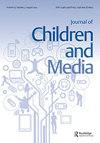Conceptualizing U.S. educational television as preparation for future learning
IF 2.1
3区 心理学
Q2 COMMUNICATION
引用次数: 1
Abstract
ABSTRACT Children sometimes fail to transfer lessons gleaned from educational television. However, exposure to this content might impart foundational knowledge that facilitates children’s learning from subsequent formal instruction. This possibility is consistent with the predictions of a theoretical framework known as “preparation for future learning” (PFL). In the current experiment, 4- to 6-year-old children (N = 109) watched one of three educational science programs about buoyancy or a control program about magnification. Afterward, all children observed a live demonstration about buoyancy and participated in two assessments of learning (i.e. once after television exposure and again after the live demonstration). Children who watched the buoyancy programs performed better across more assessments than children who watched the control program. Unexpectedly, more consistent benefits emerged among children who watched animated (vs. live action) programs. These findings provided mixed support for the PFL framework, and recommendations for future research are provided. IMPACT SUMMARY Prior State of Knowledge: Children sometimes fail to transfer lessons gleaned from educational television. However, this content might impart foundational knowledge that facilitates children’s learning from subsequent formal instruction. This possibility is consistent with a theoretical framework called “preparation for future learning” (PFL). Novel Contributions: Children learned more from formal instruction about buoyancy after exposure to similar lessons in narrative-based science television programs about buoyancy. However, the pattern of results across outcomes provided mixed support for the PFL framework. Practical Implications: Scholars might consider applying certain aspects of the PFL framework to their research designs and theorizing. Parents and teachers might consider supplementing formal instruction with educational television.将美国教育电视视为未来学习的准备
摘要孩子们有时无法转移从教育电视上学到的东西。然而,接触这些内容可能会传授基础知识,促进儿童从随后的正式教学中学习。这种可能性与被称为“为未来学习做准备”(PFL)的理论框架的预测一致。在目前的实验中,4至6岁的儿童(N=109)观看了三个关于浮力的教育科学节目之一或一个关于放大的控制节目。之后,所有孩子都观看了一场关于浮力的现场演示,并参加了两次学习评估(即一次在电视曝光后,另一次在现场演示后)。观看浮力项目的儿童比观看对照项目的儿童在更多的评估中表现更好。出乎意料的是,在观看动画(与真人)节目的儿童中,出现了更一致的好处。这些发现为PFL框架提供了混合支持,并为未来的研究提供了建议。影响总结先前的知识状态:儿童有时无法转移从教育电视中收集的课程。然而,这些内容可能会传授基础知识,促进儿童从随后的正式教学中学习。这种可能性与一个名为“为未来学习做准备”(PFL)的理论框架是一致的。小说贡献:孩子们在接触了基于叙事的科学电视节目中关于浮力的类似课程后,从关于浮力的正式教学中学到了更多。然而,各成果之间的成果模式为PFL框架提供了好坏参半的支持。实际意义:学者们可能会考虑将PFL框架的某些方面应用于他们的研究设计和理论。家长和老师可能会考虑用教育电视来补充正式教学。
本文章由计算机程序翻译,如有差异,请以英文原文为准。
求助全文
约1分钟内获得全文
求助全文

 求助内容:
求助内容: 应助结果提醒方式:
应助结果提醒方式:


